Non-food Shopping
Unit Five: Are you Good at Shopping?
5.3 Non-food Shopping
Word Bank | Phrase Bank | Communication Box |
Stationer’s ready-made clothes footwear perfumery leather goods detergents casual clothes household goods | To be aware of something To lose count of something To remove price tags To run out of something To get a discount To carry somebody away To be neither loose nor tight on somebody | It’s a real bargain. It’s just the thing! |
I. Conversation Warm-up
Look at the pictures and say which store you visit more often and why.


Example: As for me, I go to the stationery very often, because I buy new pens or
II. Pronunciation Warm-up
Read and practise the sounds /æ/, /ә/. Answer the questions of the dialogue.
SHOPPING DIALOGUE
– What have you got in your shopping bag?
– A pair of trainers,
A nice brown cap,
A T-shirt,
Sport trousers,
Two woolen socks,
A red-and-white football In a wooden box.
– Have you been to the department store?
– No, I have to be at the match at four.
III. Grammar Smart
1. Play a grammar tennis game asking for request, offering or just doubting.
Example: A: Would you like new shoes?
B: Oh, I’d love to.
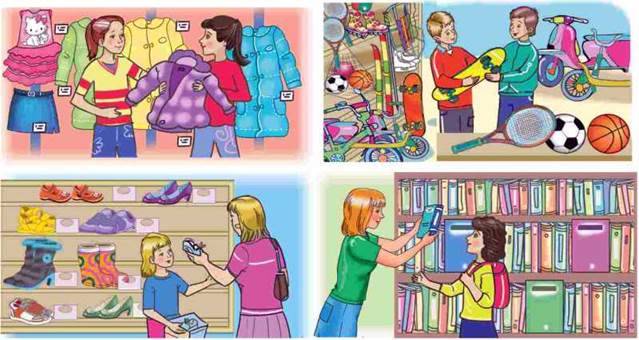
2. Complete the dialogues under the pictures.
Example:
– Should I buy a green blouse or a red one?
– I advise you to buy this one. It is just your style!
– Would you like… ?
– Not really… .
– Shall I…? –
Sure.
– You’d better… .
– Oh, thank
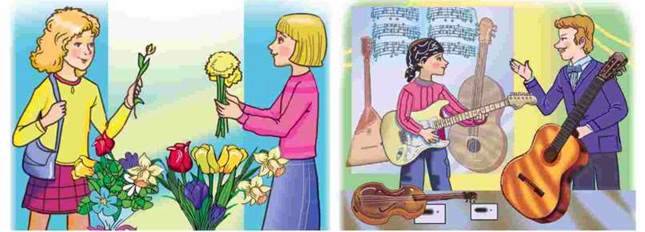
– Should I… or… ?
– I think… .
– Would you like… ?
– Exactly. I… .

3. Look at the pictures and say what you should/must or had better do.
Example: You should buy clothes on sale. They are much cheaper.
IV. Word Smart
1. Match the definition to the names of the shops and make up your sentences with them.
2. Look at the pictures and say where you can buy the following things.

Example: My mother buys detergents at the household goods.
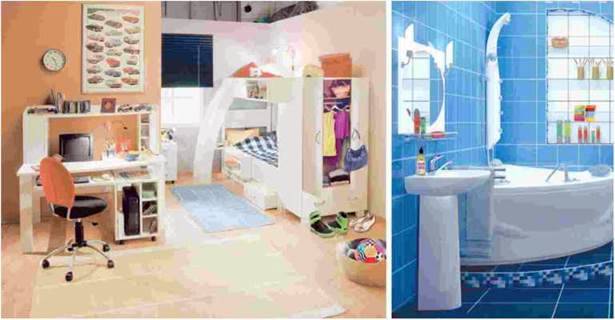
Example: We can buy clothes at the ready-made clothes department.
3. Follow the chart and describe your non-food shopping. Add more ideas to every step.
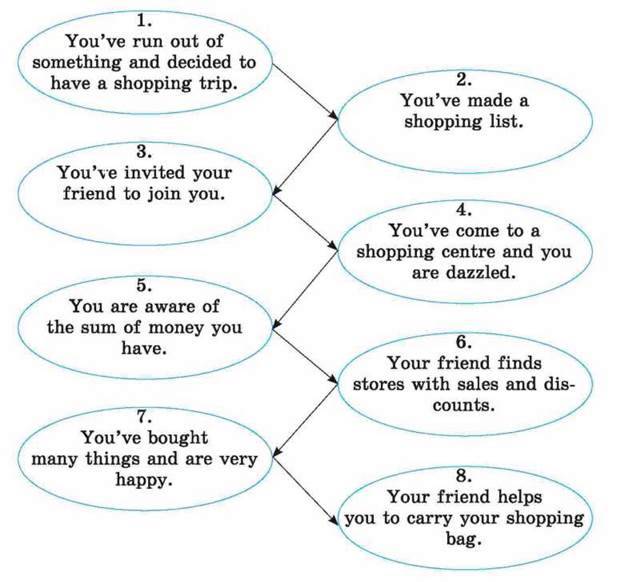
At home: Write what you like or dislike about non-food shopping. Consider the following points:
– Planning a shopping trip.
– Trying things on.
– Making choices.
– Sales.
– Discount.
– Spending much time.
– Spending much money.
Go to Ex. 77, 78 of your Workbook
V. Time to Listen and Read
1. Listen to / read a part of the story “Sweet Liar” and say if Samantha was an experienced shopper.
SWEET LIAR
…Samantha lived in New York with her guardian Mike. Today they were walking to Fifth Avenue – Mike was taking her shopping. They hurried past store after store with beautiful clothes in the windows. They were wonderful and stylish: blouses made of silk, sweaters and jackets made of wool and leather, cotton skirts and trousers. She was carried away by their beauty.
The more she saw them, the worse she felt: she was aware of her awful clothes. She was dazzled at what she saw.
Soon they met Mike’s cousin Vicky and he asked her to buy a lot of clothes for Samantha as she knew much about clothes for girls.
About half an hour later Samantha was awfully tired. When she was a child, she had often gone on shopping tours with her mum and they had a lot of fun. However, even when she had been with her mother, she didn’t have such a good time as she had on this day.
At first she chose a few dresses and tried them on in the fitting room. When she looked at herself in the mirror, she found she looked boring. When Vicky offered her help, Samantha agreed willingly. She put on a perfect-fitting suit offered by Vicky and she didn’t recognize herself. It was just the thing! Neither lose nor tight on her. The more she looked at herself the more she liked her new clothes.
Samantha bought many, many items. She lost count of all the shoes, dresses and casual clothes.
“All this costs too much”, she said. But Vicky removed price tags…
Adapted from “Sweet Liar” by Jude Deveraun
The more… the more
The more… the worse
See First Aid Kit, Grammar, p. 213
Across Culture

New York City – найбільше місто США, головний бізнес-центр країни.
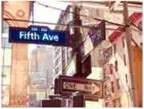
Fifth Avenue – вулиця в Нью-Йорку, відома своїми дорогими магазинами.
2. Read the sentences and say the same. Use the more…
Example: Read much and then you know more. → The more you read the more you know.
1. Have many sport activities, then you’ll feel better. ->
The more… the better… .
2. Eat many fruits and vegetables, then you’ll be he>
The more… the he>
3. Write more and then you’ll make few mistakes. ->
The more… the fewer… .
4. Read more every day and you can finish the book soon. ->
The more… the sooner… .
5. Play more and soon you’ll become a champion. ->
The more… the sooner… .
6. Listen to the native speakers more and then you’ll have a good pronunciation. ->
The more… the better….
3. Agree or disagree with what is said about Samantha’s feelings on her shopping trip. Explain the reasons.
Example: – Samantha was afraid to do the shopping.
– Agreed. The girl was in New York for the first time and was afraid.
1. Samantha felt ashamed.
2. Samantha was shy.
3. Samantha was terrified.
4. Samantha was happy.
5. Samantha felt sorry.
VI. Time to Communicate
1. Act as Samantha and describe your shopping trip to the department store. Use:
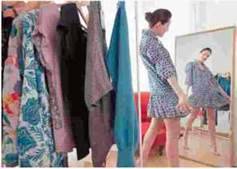
– to be aware of something;
– to be dazzled;
– to try something on;
– to offer help;
– to remove tags;
– to lose count of something.
2. In pairs, talk about your non-food shopping as in the pattern. Pattern:
A: I say… I’ve run out of… . What about… ?
B: With pleasure. I’m so fond… .
A: Great! What store… ?
B: Firstly, let’s go… and… . There is a sale and… .
A: And where can we… ?
В: Is it at… . There is always a big selection…. I went there last Sunday and… .
A: Should I… or… ?
В: I think you’d better… on the safe side.
A: Thank you… , you know much about….
B: My pleasure.
3. Describe your most memorable non-food shopping trip.
VII. Time to Write
Write about your non-shopping before Christmas. Follow the plan.
PLAN
1. Do you plan your shopping trip ahead?
2. What shops do you usually go to?
3. With whom do you usually do the shopping?
4. How long does it take you to do the shopping?
5. What do you feel doing the shopping?
Go to Ex. 79, 80 of your Workbook
